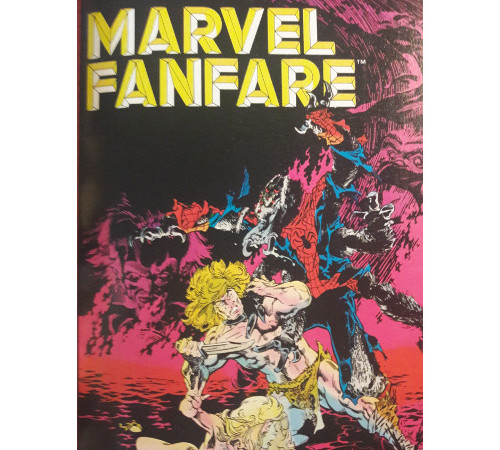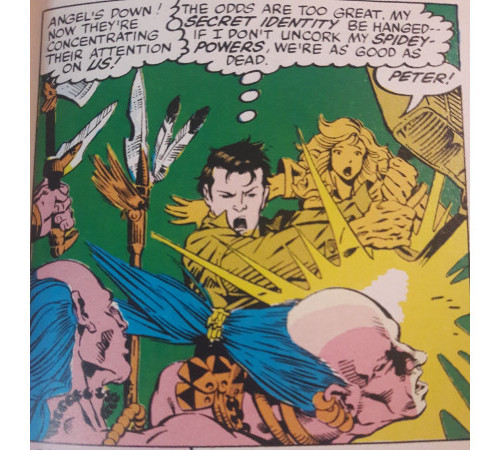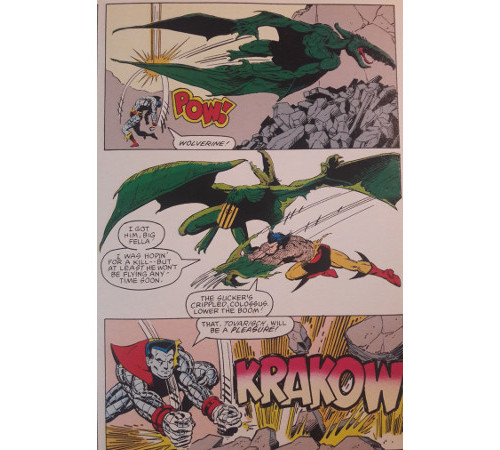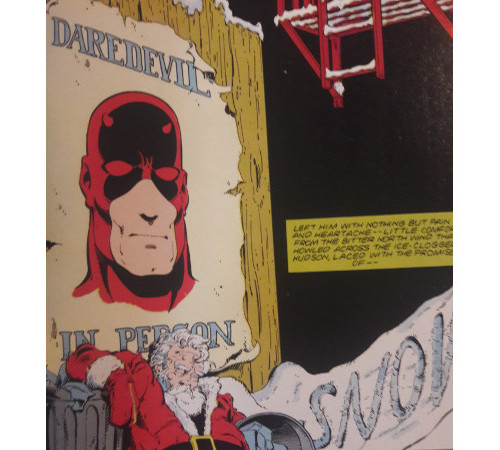Spider-view: Marvel Fanfare #1-4
Chris Claremont kicks off a 1980s series with a near perfect take on Spider-Man
—by Nathan on May 19, 2020—

Journey with me, if it so pleases you, into the exotic, legendary land of the past. A “Land Before Time,” if you will, because this era certainly precedes my living memory. We send our minds back to 1982, a year where a brand new series was published by Marvel Comics: Marvel Fanfare. Though I’m not too familiar with the series, I’ve read that it was intended to be a showcase of top-tier talent, writers and artists who could create well-written, gorgeously drawn storylines, one main narrative and one back-up strip per issue. As far as I can tell, the title is intended to be a play on words: not only could Marvel release a title with a dash of flourish (hence the "fanfare") by utilizing top talent, but they could gear it towards audiences looking for a high-quality book featuring popular creators and starring favorite characters (a kind of "fare" specifically for "fans," if you will). As a result, Marvel had a nicely designed book on their hands that they could sell for a whopping $1.25 an issue!
Even though this 80s title wasn’t intended to be a Spider-Man series, Marvel thought it prudent to have him star in the first couple of issues. He is, after all, their flagship character, and if you’re charging double the price of a typical Spider-Man comic in 1982, you’re gonna wanna make it good.
“Fatal Descent into Hell”
Writers: Chris Claremont (main narrative), Roger McKenzie (back-up strips, issues #1-2), Charlie Boatner (back-up strip, issue #3), David Anthony Kraft (back-up strip, issue #4), David Winn and David Michelinie (back-up strip, issue #4)
Pencilers: Michael Golden (main narrative, issues #1-2; back-up strip, issue #4), Dave Cockrum (main narrative, issue #3), Paul Smith (main narrative, issue #4; back-up strip, issue #1), Trevor von Eeden (back up strips, issues #2 and #3)
Issues: Marvel Fanfare #1-4
Publication Dates: March 1982-September 1982

Before we begin, a small note: while I will be reviewing the first four issues of Marvel Fanfare, this is simply because they all belong to the same story arc. Spidey only appears for the first two issues, meaning they’ll receive the bulk of my word count, with briefer comments made on the third and fourth issues, as well as the back-up strips.
On to the review.
Several years ago, for some reason, I decided to read a small chunk of Chris Claremont’s legendary run on X-Men, a portion that spanned the issues immediately after Giant Size X-Men #1 (which introduced readers to the new core team consisting of Colossus, Storm, Wolverine, Nightcrawler, Banshee, Sunfire, and Thunderbird, before his untimely death) through “The Dark Phoenix Saga" (Claremont’s epic cosmic saga that spawned not one, but two awful X-Men movies). I loved the experience of reading Claremont’s work and, even though I’ve never taken a proper second examination of his time on X-Men, Claremont’s narratives, penned alongside artists such as John Byrne and Dave Cockrum, remains some of the best series of stories I’ve ever read in comics. Those issues are some of the few non-Spidey stories I’d seriously consider collecting one day. Claremont’s character work is gorgeous, especially with X-Men members such as Jean Grey, Wolverine, and Kitty Pryde, serving as a wonderful successor to Stan Lee and Steve Ditko’s run on the book (which is also highly enjoyable). He takes what was then a defunct comic and transforms it into a sprawling epic filled with heart, drama, superhuman action, and relatable characters you sympathize with. Yeah, even Wolverine.
Seeing that Claremont had not only written these Fanfare issues but brought Spidey along for the ride made me smile as soon as I opened the book. Immediately, Claremont’s words spring to life, his dialogue energetic and Golden’s characters reminding me of how much I enjoyed those X-Men tales years earlier. Claremont’s reintroduction of X-Men villain Sauron, created by Roy Thomas and the legendary Neal Adams, was a beautiful sight. Given my limited knowledge of the X-Men’s legacy, I hold Sauron to be an extremely interesting yet woefully underappreciated villain, cast aside for the likes of more popular foes such as Magento, Mr. Sinister, the Juggernaut, and the Hellfire Club. I loved Adams’ work on him during Thomas’ run on the book, and Claremont’s utilization of the character feels like not only a continuation of Thomas and Adams’ story but also a Savage Land-centric arc Claremont himself had written a few years prior. Sauron’s an energy-draining pterodactyl named after Middle Earth’s most fearsome antagonist! What’s not to love?
As Peter Parker, Spidey is sent on a Daily Bugle assignment to the Savage Land along with Warren Worthington III, the high-flying X-Men known as the Angel, as well as Tanya Anderssen, former girlfriend of Karl Lykos, Sauron’s human alter ego. Claremont ties in all kinds of wonderful continuity here--not only is the Savage Land tethered to his and Thomas’ stories and characters, but he brings back the Savage Land Mutates created by Thomas and even references an old Spider-Man story where Peter Parker visited the Savage Land with Gwen Stacy while on assignment for J. Jonah Jameson. All these details don’t seem important, but for anyone familiar with the stories and characters, Claremont’s attention to continuity forges a colorful tapestry of interwoven tales and ideas, reminding you just how vast and connected the Marvel Universe is. I had actually forgotten the “Spidey in the Savage Land” story when I read this, so I appreciated the reminder. It’s a tad coincidental that the Bugle sends their one photographer with superpowers on this potentially dangerous trip, but Claremont’s ability to weave in references to past stories smooths over any rough patches.

Though attending the trip as Peter, our hero soon dons the webs to protect Tanya and is ultimately captured with Angel by the Mutates. He and the Angel are hideously transformed into devolved abominations--Peter becoming a six-limbed, spidery monster, and Angel turning into a giant, frightening eagle with talons. Golden provides eerie designs for both characters and makes Spidey into a fairly horrific monster. The creatures battle Ka-Zar, Lord of the Savage Land, as well as his sabretooth tiger companion Zabu and a legion of Savage Land natives, who all hold their own surprisingly well.
Claremont’s characterization of Spidey is on-point, even as a rampaging giant arachnid, crafting an inner turmoil between the monstrous side of Spidey and the deeper, self-sacrificial part of him that remembers his call to responsibility. This humanity doesn’t exist for the Angel, or is at least not embedded in his character as deeply as it is with Spidey, so I can only believe that Claremont did his best to shape an accurate portrayal of Spider-Man, knowing the hero’s history with the personal responsibility that comes with his powers. Peter’s reason for being on the trip may be coincidental, but it’s nevertheless impactful and carries weight. And I’m not even mad that Claremont took my favorite hero and mutated him into a monster. The transformation adds tension to the story; you feel torn as you watch others battle their once-human ally. You don’t necessarily enjoy seeing Spidey turned into a monster, but once he’s in the ring, you don’t want to see him get pounded on either.
The one area Claremont’s use of Spidey flags is that no explanation is ever given as to why Spidey suddenly appears in the Savage Land. When Tanya and a plainclothes Peter are attacked by warriors under the Mutates’ thrall, our hero decides to fight back. Secret identity be hanged, he thinks. If I don’t uncork my powers, we’re as good as dead. While potentially abandoning his secret identity to escape a situation where his powers are useful is not the rarest occurrence in Spider-Man lore, it’s a scenario which is often fraught with risk for both the character and storyteller alike: how does one explain Peter’s sudden burst of speed or sudden strength? Writers often resort to coincidences after backing themselves into the particular corner. The problem continues later on, where, in full costume, Peter is transformed with Angel into his monstrous form and, when the process is reversed, a fully human Peter collapses to the ground, still wearing tatters of his Spidey outfit.

Claremont’s solution to this problem is to simply not mention it. Karl Lykos, Ka-Zar, Tanya, and Angel are all present for this transformation, and yet, no one says anything about it. I don’t know if this issue comes up in future team-ups between Spidey and the X-Men or Ka-Zar, but for a character who so intently guards his secret identity, I’m surprised Claremont doesn’t address this problem. Maybe Peter could’ve gotten away with showing off some of his battle prowess when he defended Tanya, maybe citing martial art training or some other general reasoning, but I think it’s much harder to explain away why your mutated spider-form, with a costume that clearly belongs to Spider-Man, transformed back into a young man with a known history of Spidey encounters. As accurate as Claremont's portrayal of Spidey's/Peter Parker's personality is, this is one area where he slightly falters.
Spidey vanishes after issue #2, bringing in the X-Men for our final half. Similarly to when I read the first issue of this series, I couldn't help but react positively to the X-Men's appearance here. My mind was taken back to those days of reading Claremont's narratives and how easily enraptured I became. The X-Men's half of this story sees them pitted against Sauron, who soaked up the energies from Spidey and Angel to turn them back into Peter and Warren, and thus became his mutated, pterodactyl self. Claremont injects some wonderful empathy for the character here, presenting Sauron as a troubled Doctor Jekyll/Mr. Hyde figure. Though Karl’s intentions for helping Spidey and Angel are genuine, it comes with the unfortunate side-effect of his monstrous transformation, setting the stage for the next two issues. You feel for Karl’s situation, with Claremont shaping him as more a victim of a curse than an outright villain. It leads you to feeling empathy for the character when he’s attacked by Wolverine or battered by Storm’s winds, knowing a man still exists beneath the prehistoric hide. And Claremont doesn’t even set Lykos up as a character who only pretends to be heroic when, surprise, he’s been the villain all along! No, Lykos’ humanity is genuine here.

These final two issues transform the tale into something close to dystopian, with the X-Men battling to free the Savage Land from Sauron’s clutches. Some of the story beats feel a bit too similar to the Spidey issues--several heroes are captured by their foes and at least one X-Men member is subjected to the same energy that turned Spidey and Angel into their feral counterparts. These two issues certainly feel more action driven than character driven; Claremont’s biggest attempts at inserting character moments include a monologue from Wolverine about how killing out of necessity does not equal murder, which could have taken an interesting philosophical turn had it not felt shoved into the scene it appears in and actually turned into a conversation permeating the story. As it’s left, this standalone remark made by Wolverine feels more like an attempt by Claremont at saying “Hey, kids, remember Wolverine? He’s the guy with the claws who kills people, so we’ll have him discuss the merits of killing people!” than providing any dramatic insight.
Nothing here matches the nice character work Claremont weaves with Spidey in the story’s first half. I enjoy Claremont’s issues with Spidey over the issues starring the X-Men, which is probably because (1. I just really like the character of Spider-Man more, despite Claremont’s excellent work on the mutant team, and (2. those first two issues really feel more thought-out than the second half of the story. A slight disappointment, given Claremont’s beautiful, legendary X-Men run, but it’s also understandable that, considering the X-Men only appear for half the story, their arc wouldn’t feel as strong as if they were given starring power through all four issues.

Each issue of Fanfare came with a second, smaller story by various writers and authors. Across these first four issues, these back-up strips range from really well-done to the mediocre. Standout stories include a Christmastime tale where Daredevil hunts down thugs who mugged a Salvation Army Santa as well as a story where Mr. Fantastic, on the verge of a breakthrough in finding a cure for his friend the Thing, sacrifices his latest invention to keep Annihilus from conquering the world. The other stories, starring characters such as Hawkeye, Iron Man, and Deathlok, don’t feel as fleshed out in the pages they’re allotted. The Iron Man story in particular feels like it wastes the space it’s given, coming across as a really short one-and-done tale about Tony Stark subconsciously confronting his demons that reaches for too much and comes up short in trying to create something substantial or meaningful. I assume this comes down to sharing space with a second back-up story concerning Deathlok, which works slightly better. But both tales are, regrettably, relegated to a mere five pages and don’t have time to develop. The disappointment is heightened when you remember that David Michelinie, who writes the Iron Man back-up strip, had a well-loved run on Invincible Iron Man, and though I haven't read much of it, I was honestly bummed that the writer behind the "Demon in a Bottle" story arc (which is great) couldn't craft a more entertaining tale.
Marvel Fanfare is an entertaining experiment. Does it wholly succeed at its premise, bringing in top-tier storytellers for top-tier story development? Not always. Here and there, the back-ups are impressive, but none surpass Claremont’s writing. Crisp dialogue and a sympathetic villain help to overlook some of the hang-ups, which is something most of the other contributing writers and artists don’t always have going for them. But for Claremont’s words alone, masterful narration from an iconic writer during his heyday, this story may have well been worth your $1.25 an issue.